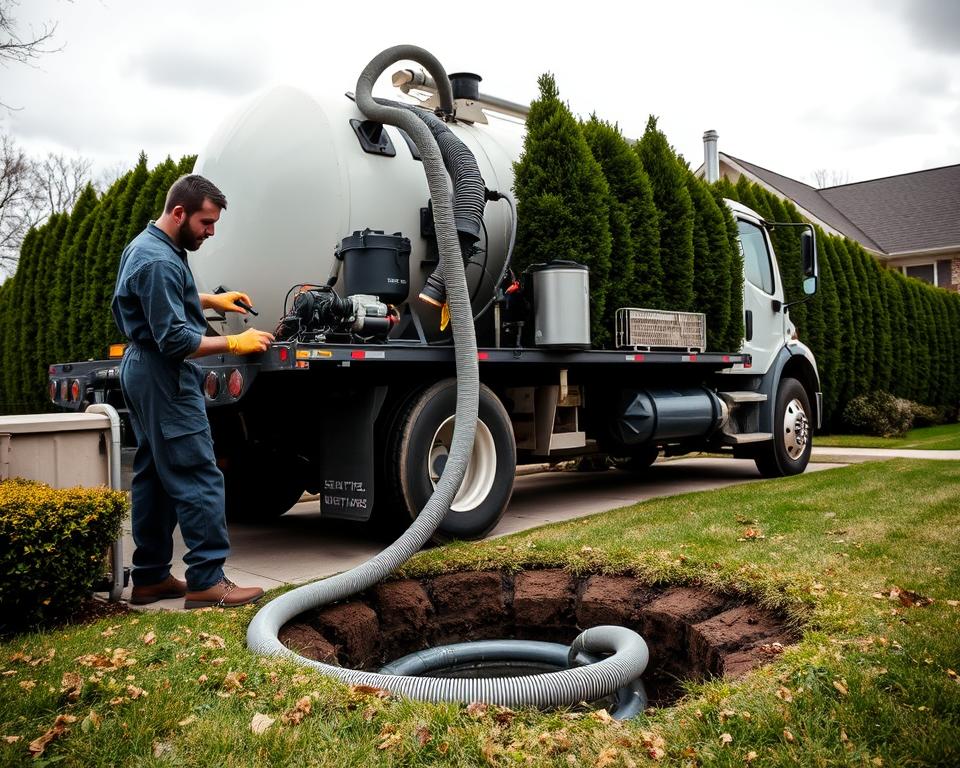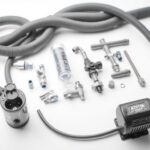Septic Aerator Unit: Essential Guide for Property Owners
Curious about what powers your aerobic Septic setup’s efficiency? The air Pump in your Septic system is the little-known hero crucial for your system. Throughout this overview, readers will gain practical know-how on the device’s role. It’s critical for a robust, effective Septic tank.
Appreciating the necessity of a Septic tank air Pump can enhance your Septic system’s functionality using septic inspection. It also preserves your asset value and local environment. The following guide will introduce All in Sanitation, a leading Septic industry authority. They’re eager to meet your Septic aerator Pump demands.
Vital Takeaways
- The Septic air Pump is indispensable for oxygen-based Septic setups.
- Properly caring for your Septic system air Pump can boost overall system function.
- Periodic reviews prolong the lifespan of your Septic tank air Pump.
- Selecting the correct Septic aerator Pump is essential for top operation.
- All in Sanitation supplies expert services for Septic air Pump needs.
Exploring Aerobic Septic Units
Aerobic Septic systems present a enhanced waste treatment option by using oxygen. This technique features aerobic bacteria living in well-oxygenated environments. These bacteria are better in digesting organic matter. With the help of Septic aerator Pumps, these systems deliver a consistent oxygen supply, improving the waste decomposition process.
These systems perform well in minimizing sludge buildup, thanks to the effectiveness of aerobic bacteria. This cut in solid waste means less maintenance and tank Pump-outs is required. Additionally, they effectively manage wastewater, creating minimal smells. This ensures a better environment for homeowners and the community overall.
To ensure these systems operate efficiently, it’s crucial to understand the key Septic system components. These include the Septic tank, treatment chamber, and effluent Pump. Each component is vital, especially the air Pump. It forces oxygen into the tank, crucial for the aerobic bacteria’s performance.
Role of the Septic Air Pump
The Septic air Pump is pivotal in the performance of aerobic Septic systems. It acts as the system’s “air provider,” providing the vital oxygen essential. This oxygen enables aerobic bacteria to prosper and decompose waste quickly. If the Pump malfunctions, the system’s efficiency decreases, resulting in sludge accumulation and possible odors.
Such issues can disrupt Septic system operations and lead to environmental hazards. By acknowledging how critical the Septic air Pump is, homeowners can take proactive steps. They can ensure its top function through regular maintenance. This wards off failures, reduces costly repairs, and keeps the aerobic system’s condition.
Primary Gains of Using a Septic Air Pump
Operating a Septic air Pump greatly improves the performance of Septic systems. Septic air Pumps are essential as they accelerate the decomposition of waste. This is realized by oxygenating the treatment process, supporting aerobic bacteria growth. These bacteria are essential for successful waste treatment.
They’re also useful in cutting foul smells. With more active aerobic processes, waste decomposes faster, thus diminishing odors. This provides a fresher environment for homeowners.
Another significant benefit is the decrease in sludge collection. Consequently, tanks demand less frequent Pumping, conserving both money and time. Improved processing not only reduces spending but also increases the lifespan of the drain field.
Maintaining these Pumps properly means reduced repair costs and complying with regulatory standards. Thus, the advantages of Septic air Pumps go beyond being for homeowners. They also enhance environmental health by optimizing waste management practices.
| Benefit | Description |
|---|---|
| Fast Waste Breakdown | Enhanced aerobic activity speeds the decomposition process. |
| Minimized Odor Emissions | Superior treatment efficacy produces fewer odors. |
| Reduced Sludge Buildup | Minimal Pumping and maintenance are required. |
| Extended Drain Field Life | Better treatment translates to a healthier drain field. |
| Cost Savings | Lower risk of repairs and regulatory compliance cost. |

Picking an Ideal Septic Air Pump
Selecting the best Septic air Pump is essential for an optimized aerobic system. Homeowners should assess various factors for the perfect selection. The volume of the tank and the airflow demands significantly influence the Pump’s output.
To choose intelligently, it’s useful to be aware of the air Pumps available. There are mainly two types: diaphragm Pumps and rotary vane Pumps. Each provides unique benefits, which should be matched with your home’s specific needs and operational profile.
Energy use also is a factor. Selecting a Pump that cuts energy use while supplying the needed airflow can yield meaningful reductions. Assistance from All in Sanitation specialists can be extremely useful. They help ensure the Pump you choose fits your system’s requirements seamlessly.
Common Types of Septic Air Pumps
Homeowners can decide more effectively by understanding the various Septic air Pumps available. There are mainly two types: diaphragm Pumps and rotary vane Pumps. Each has its particular functions and benefits.
Diaphragm Pumps, famous for their quiet operation, are popular for residential Septic systems. They offer energy efficiency while providing steady air flow. Their dependable performance is ideal for smaller systems, meeting the needs of many homeowners.
Rotary vane Pumps, however, are ideal for extended or commercial systems. These Pumps offer higher capacity, needed for handling bigger loads. Their solid build ensures efficient operation in large-scale Septic systems.
| Type of Pump | Best Use | Advantages |
|---|---|---|
| Diaphragm Pumps | Residential Systems | Quiet operation, energy-efficient, reliable air flow |
| Rotary Vane Pumps | Larger or Commercial Systems | Powerful performance, high capacity, durable construction |
Recognizing the contrasts in Septic air Pumps is key for upgrades or replacements. Each Pump type offers unique qualities to fulfil various needs. This guarantees optimal performance for any system.
How to Tell You Need a Septic Air Pump Replacement
Homeowners must watch for Pump failure signs in their Septic systems. Some symptoms point towards the need for a Septic air Pump replacement. These support reliable function. Spotting these early stops larger issues.
Signs of potential problems include:
- Unusual noises from the Pump, like clanking or shaking, might suggest internal damage.
- A clear lack of air output means the Pump isn’t functioning properly, reducing efficiency.
- Frequent electrical problems, such as blown fuses or voltage drops, could suggest overloading.
- Visible damage on the Pump unit, with fractures or leaks, demands quick action.
- Unpleasant odors in the yard often signal a compromised Pump, meaning ineffective effluent aeration.
Finding these signs early prevents costly fixes or total system failure. Performing regular checks makes it easy to catch these issues. It also demonstrates if you require a new Septic air Pump.
Service Tips for Your Septic Air Pump
For an well-running Septic air Pump, consistent service is crucial. This makes sure that your system operates correctly. Homeowners can apply several simple care strategies for maximum results.
Twice a year, conduct a careful inspection for wear or damage. It is also crucial to change the filters as indicated. This prevents clogs that could lower efficiency.
The Pump should be placed on a stable base to reduce vibrations, which could damage it over time. A protective cover is important too. It shields against debris and water, maintaining the Pump’s functionality.
Regular servicing can notably extend the life of your Pump. In turn, this enhances the Septic system’s performance as a whole.
| Maintenance Task | Frequency | Benefits |
|---|---|---|
| Inspect Pump for damage | Every 6 months | Finds faults promptly |
| Replace filters | As needed | Improves efficiency |
| Check surface stability | Annually | Minimizes shake |
| Clear debris around Pump | Monthly | Avoids obstruction |
Fitting Your Septic Air Pump
Proper installation of your Septic air Pump is essential for its smooth operation. At the outset, pick a reliable, moisture-free area for placement. The chosen spot should reliably accommodate the Pump’s weight easily.
To effectively install your Pump on your own, heed the following guidelines:
- Assemble all necessary items, including the Pump, a power source, and hose fittings.
- Check the manufacturer’s guidelines before commencing your installation.
- Confirm every connection is proper to stop air leaks that compromise performance.
- After assembly, conduct a test to ensure the system works as intended.
If the installation process seems daunting, reach out to All in Sanitation. Their professionals can avoid common errors, confirming your setup meets necessary safety requirements.
Reasons to Select All in Sanitation for Your Septic Air Pump Requirements
When selecting a Septic service provider, the choice is key. All in Sanitation separates itself by offering dependable Septic air Pumps. They cater to wide-ranging homeowner requirements with a extensive selection of quality products. This ensures customers find an ideal match for their Septic systems.
What further defines All in Sanitation is more than their diverse product lineup. Their focus to excellent customer service is also critical. Homeowners benefit from knowledgeable support, steering them toward trusted Septic solutions. This partnership is key to customize each solution to match specific needs.
All in Sanitation also focuses on aftercare to secure lasting satisfaction. Their promise goes beyond the initial sale. They offer ongoing support to preserve Septic systems functioning optimally for the long haul.
Financial Aspects for Septic Air Pumps
Knowing the price factors connected with Septic air Pumps is vital for homeowners using aerobic Septic systems. To start, one faces the price tag, which includes the Pump and necessary accessories. Installation expenses change, in line with the system’s complexity and any alterations required.
Ongoing upkeep forms an additional cost layer. Periodic reviews can prevent bigger issues, which can mean savings. Homeowners should allocate money for Septic maintenance to retain the Pump’s effectiveness and life expectancy. Such planning sidesteps expensive repairs later on, highlighting the advantage of proactive maintenance.
| Cost Component | Average Cost Range |
|---|---|
| Septic Air Pump | $500 – $1,200 |
| Installation | $300 – $800 |
| Annual Maintenance | $150 – $400 |
| Potential Repair Costs | $1,000 – $5,000 |
Breaking down Septic air Pump expenses into separate parts supports homeowners in budget planning. This thorough approach secures the system’s consistent operation and their confidence.
In Closing
For homeowners with aerobic Septic systems, looking after Septic units is vital. The proper Septic air Pump optimizes waste processing and extends your system’s life. Scheduling consistent service and swiftly handling issues stops expensive repairs and disruptions.
Picking a Septic air Pump warrants careful thought. This guide covered how to make smart choices about installation and replacement. With All in Sanitation’s support, you can manage your Septic systems’ complexities securely.
Attending to your Septic air Pump supports your system’s operation and durability. It ensures a smooth and effective operation over time. Keep in mind, your home’s wastewater management relies heavily on regular attention.

